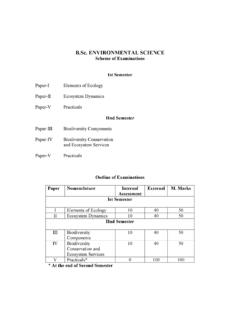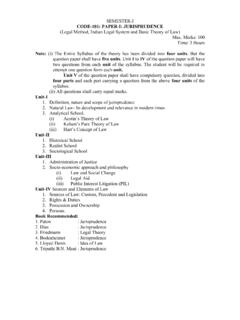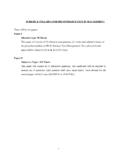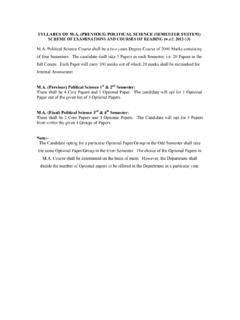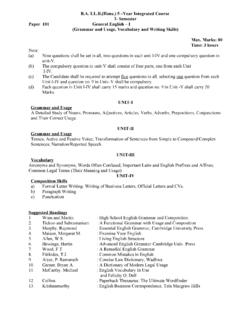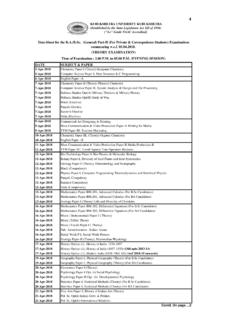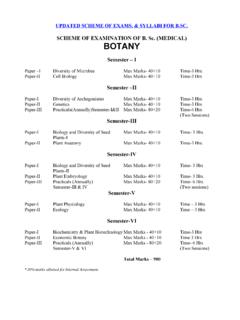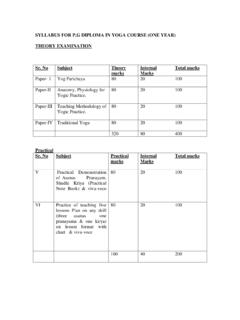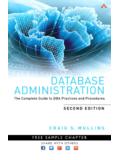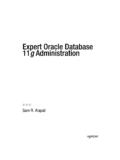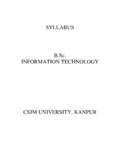Transcription of B.Sc. (Computer Science) – First Year - Kurukshetra
1 ( computer Science) First year Paper No. Title of Paper External Marks Internal Assessment Maximum Marks Pass Marks Exam Durations Semester I I computer Fundamentals & Programming in C 40 5 45 16 3hrs II Logical Organization of computer -I 40 5 45 16 3hrs III Practical (Programming in C ) 60 24 3hrs Semester II IV PC-Software 40 5 45 16 3hrs V Logical Organization of computer II 40 5 45 16 3hrs VI Practical (PC-Software) 60 24 3hrs ( computer Science) - Second year Paper No. Title of Paper External Marks Internal Assessment Maximum Marks Pass Marks Exam Durations Semester III I Data Structures using C 40 5 45 16 3hrs II Structured system Analysis & Design 40 5 45 16 3hrs III Practical (Implementation of data structure in C ) 60 24 3hrs Semester IV IV Operating Systems 40 5 45 16 3hrs V Programming in Visual Basic 40 5 45 16 3hrs VI Practical (Visual Basic) 60 24 3hrs ( computer Science) - Third year Paper No.
2 Title of Paper External Marks Internal Assessment Maximum Marks Pass Marks Exam Durations Semester V I Programming in C++ 40 5 45 16 3hrs II Introduction to Data Base Systems 40 5 45 16 3hrs III Practical ( C++ ) 60 24 3hrs Semester VI IV computer Networks 40 5 45 16 3hrs V relational database management system 40 5 45 16 3hrs VI Practical (ORACLE) 60 24 3hrs PAPER I PROGRAMMING in C++ Note: Examiner will be required to set Nine Questions in all. First Question will be compulsory, consisting of six (objective type/short-answer type) questions covering the entire syllabus. In addition to that eight more questions will be set, two questions from each Unit.
3 A candidate will be required to answer five questions in all, selecting one question from each unit in addition to compulsory Question No. 1. All questions will carry equal marks. Maximum Marks: 45 External: 40 Minimum Pass Marks: 16 Internal: 5 Time: 3 hours UNIT I Introduction to Programming C++: Object-Oriented Features of C++, Class and Objects, Data Hiding & Encapsulation, Structures, Data members and Member functions, Inline Functions, Static Data Members and Member Functions, Friend Functions, Preprocessor Directives, Namespace, Comparing C with C++. UNIT II Constructors & Destructors: Roles and types of Constructors, Roles of Destructors, Dynamic Memory Allocation: Pointers and their Manipulation, new and delete Operators this Pointer.
4 Console I/O: Formatted and Unformatted I/O, Manipulators. UNIT III Compile-Time Polymorphism: Unary and Binary Operators overloading through Member Functions and Friend Functions, Function Overloading. Inheritance: Types of Derivations, Forms of Inheritance, Roles of Constructors and Destructors in Inheritance. UNIT IV Genericity in C++: Template Function, Template Class, Inheritance and Templates. Exception Handling: try, throw and catch constructs, rethrowing an exception, catch all Handlers. TEXT BOOKS: 1. Herbert Scildt, C++, The Complete Reference, Tata McGraw-Hill 2. Robert Lafore, Object Oriented Programming in C++, PHI REFERENCE BOOKS: 1. Bjarne Stroustrup, The C++ Programming Language, Pearson. 2. Balaguruswami, E.
5 , Object Oriented Programming In C++, Tata McGraw-Hill PAPER II INTRODUCTION TO database SYSTEMS Note: Examiner will be required to set Nine Questions in all. First Question will be compulsory, consisting of six (objective type/short-answer type) questions covering the entire syllabus. In addition to that eight more questions will be set, two questions from each Unit. A candidate will be required to answer five questions in all, selecting one question from each unit in addition to compulsory Question No. 1. All questions will carry equal marks. Maximum Marks: 45 External: 40 Minimum Pass Marks: 16 Internal: 5 Time: 3 hours UNIT I Basic Concepts Data, Information, Records and files. Traditional file based Systems-File Based Approach-Limitations of File Based Approach, database Approach-Characteristics of database Approach, database management system (DBMS), Components of DBMS Environment, DBMS Functions and Components, Advantages and Disadvantages of DBMS.
6 Roles in the database Environment - Data and database Administrator, database Designers, Applications Developers and Users. UNIT II database system Architecture Three Levels of Architecture, External, Conceptual and Internal Levels, Schemas, Mappings and Instances. Data Independence Logical and Physical Data Independence. Classification of database management system , Centralized and Client Server architecture to DBMS. Data Models: Records- based Data Models, Object-based Data Models, Physical Data Models and Conceptual Modeling. UNIT III Entity-Relationship Model Entity Types, Entity Sets, Attributes Relationship Types, Relationship Instances and ER Diagrams. Basic Concepts of Hierarchical and Network Data Model.
7 UNIT IV relational Data Model:-Brief History, relational Model Terminology- relational Data Structure, database Relations, Properties of Relations, Keys, Domains, Integrity Constraints over Relations, Base Tables and Views. TEXT BOOKS: 1. Elmasri & Navathe, Fundamentals of database Systems , 5th edition, Pearson Education. REFERENCE BOOKS: 1. Thomas Connolly Carolyn Begg, database Systems , 3/e, Pearson Education 2. C. J. Date, An Introduction to database Systems , 8th edition, Addison Wesley N. Delhi. PAPER IV computer NETWORKS Note: Examiner will be required to set Nine Questions in all. First Question will be compulsory, consisting of six (objective type/short-answer type) questions covering the entire syllabus.
8 In addition to that eight more questions will be set, two questions from each Unit. A candidate will be required to answer five questions in all, selecting one question from each unit in addition to compulsory Question No. 1. All questions will carry equal marks. Maximum Marks: 45 External: 40 Minimum Pass Marks: 16 Internal: 5 Time: 3 hours UNIT I Introduction to computer Communications and Networking Technologies; Uses of computer Networks; Network Devices, Nodes, and Hosts; Types of computer Networks and their Topologies; Network Software: Network Design issues and Protocols; Connection-Oriented and Connectionless Services; Network Applications and Application Protocols; computer Communications and Networking Models: Decentralized and Centralized Systems, Distributed Systems, Client/Server Model, Peer-to-Peer Model, Web-Based Model, Network Architecture and the OSI Reference Model; Example Networks: The Internet, , Frame Relay, ATM.
9 UNIT II Analog and Digital Communications Concepts: Representing Data as Analog Signals, Representing Data as Digital Signals, Data Rate and Bandwidth, Capacity, Baud Rate; Digital Carrier Systems; Guided and Wireless Transmission Media; Communication Satellites; Switching and Multiplexing; Dialup Networking; Analog Modem Concepts; DSL Service; UNIT III Data Link Layer: Framing, Flow Control, Error Control; Error Detection and Correction; Sliding Window Protocols; Media Access Control: Random Access Protocols, Token Passing Protocols; Token Ring; Introduction to LAN technologies: Ethernet, switched Ethernet, VLAN, fast Ethernet, gigabit Ethernet, token ring, FDDI, Wireless LANs; Bluetooth; Network Hardware Components: Connectors, Transceivers, Repeaters, Hubs, Network Interface Cards and PC Cards, Bridges, Switches, Routers, Gateways; UNIT IV Network Layer and Routing Concepts: Virtual Circuits and Datagrams; Routing Algorithms; Congestion Control Algorithms; Internetworking; Network Security Issues: Security threats; Encryption Methods; Authentication; Symmetric Key Algorithms; Public-Key Algorithms; TEXT BOOKS: 1.
10 Michael A. Gallo, William M. Hancock, computer Communications and Networking Technologies , CENGAGE Learning. 2. Andrew S. Tanenbaum, computer Networks , Pearson Education. REFERENCE BOOKS: 1. James F. Kurose, Keith W. Ross, computer Networking , Pearson Education. 2. Behrouz A Forouzan, Data Communications and Networking , McGraw Hill. PAPER V relational database management system Note: Examiner will be required to set Nine Questions in all. First Question will be compulsory, consisting of six (objective type/short-answer type) questions covering the entire syllabus. In addition to that eight more questions will be set, two questions from each Unit. A candidate will be required to answer five questions in all, selecting one question from each unit in addition to compulsory Question No.
